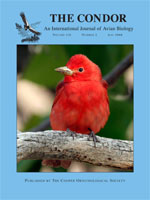We contrast patterns of variation in morphological traits of migratory and sedentary forms of the Yellow-rumped Warbler (Dendroica coronata) to test functional predictions regarding the evolution of traits related to flight. Sedentary individuals are larger than migrants in all traits except bill width and depth. However, when traits are adjusted for body size differences using multivariate approaches, migrants have longer and more concave wings than do individuals from sedentary populations, suggesting selection for high–aspect ratio wings for fast, sustained flight. Subadults have relatively shorter and rounder wings than do adults of all subspecies except for the long-distance migrant D. c. coronata, and age-related differences are most pronounced in short-distance migrants. We propose a graphic model for the evolution of age-related differences in wing shape that is based on the role of antagonistic selective pressures imposed by migratory flight vs. maneuverability. Size-adjusted differences in tail length are not significant. Longer culmens and tarsi in the sedentary D. c. goldmani subspecies of Guatemala suggest differences in diet and foraging behavior compared to migratory groups. Our results strongly suggest that divergent natural selection has caused the morphological differentiation between migratory and sedentary subspecies.
How to translate text using browser tools
1 May 2008
Ecomorphology of Migratory and Sedentary Populations of the Yellow-Rumped Warbler (Dendroica Coronata)
Borja Milá,
Robert K. Wayne,
Thomas B. Smith
ACCESS THE FULL ARTICLE

The Condor
Vol. 110 • No. 2
May 2008
Vol. 110 • No. 2
May 2008
Dendroica
ecomorphology
flight
ontogenetic shift
warbler
wing shape




